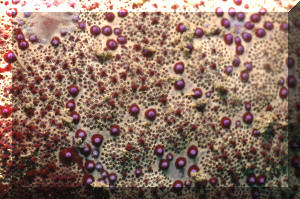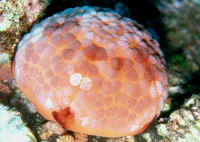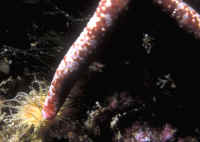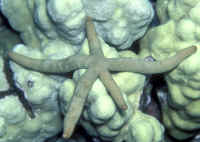|
Related FAQs: Sea Stars 1, Sea
Stars 2, Sea Stars 3, Sea Stars 4, Sea
Stars 5, Brittle Stars,
Seastar ID 1, Seastar ID 2, Seastar ID 5, Seastar ID 6 & Seastar Selection, Seastar Compatibility, Seastar Behavior, Seastar Systems, Seastar Feeding, Seastar Reproduction, Seastar Disease, Seastar Disease 2, Seastar Disease 3,
Star Disease 4, Star
Disease 5, & Asterina Stars, Chocolate Chip Stars, Crown of Thorns Stars, Fromia Stars, Linckia Stars, Linckia Stars 2, Sand-Sifting
Stars,
Related Articles:
Echinoderms, An Introduction to the
Echinoderms: The Sea Stars, Sea Urchins, Sea Cucumbers and
More... By James W. Fatherree, M.Sc. Brittle
Stars, Asterina Stars,
Crown of Thorns Seastars,
Marine
Scavengers,
Sea Stars, Class Asteroidea
part 7 of 11
To:
Part
1, Part 2, Part 3, Part
4, Part 5,
Part 6, Part 8,
Part 9, Part 10,
Part 11
|
|
|
By Bob Fenner
|
|
Genus Culcita:
Bigger PIX:
The images in this table are linked to large (desktop size) copies. Click on
"framed" images to go to the larger size. |

%20MD.JPG)
%20MD.JPG)
%20MD.JPG)


%20MD.JPG)
%20MD.JPG)

%20MD.JPG) |
| Culcita schmideliana (Retzius 1805), the
Spiny Cushion Star. Indian Ocean; eastern Africa to Malaysia. To
ten inches in diameter. In Malaysia and N. Sulawesi. |

|
Bigger PIX:
The images in this table are linked
to large (desktop size) copies. Click on "framed" images
to go to the larger size. |
|

|
| Nidoriellia armata (Gray 1840), a Chocolate Chip Sea
Star. Family Oreasteridae. To 6.6 inches in diameter. Mid to
Eastern Pacific; Hawaii, Sea of Cortez to Peru and Galapagos. Blunt
arms, large central disc, large aboral spines dark in color.
Variable color and shape. Intertidal to 73 meters, feeds on benthic
marine invertebrates, gastropods and algae. Galapagos pix
below. |
Bigger PIX:
The images in this table are linked
to large (desktop size) copies. Click on "framed" images
to go to the larger size. |
|

|
| Pentaceraster cumingi (Gray 1840), the
Panamic Cushion Star. Family Oreasteridae. To 13.4 inches in
diameter. Mid to Eastern Pacific; Hawaii, Sea of Cortez to Peru and
Galapagos. Variably red, orange to greenish blue bodied with large
red spines. Feeds on micro-fauna in substrate, benthic algae,
seagrass and other echinoderms. Usually found on sandy bottoms from
shallow to 180 meters depth. Galapagos pics. |

|
Bigger PIX:
The images in this table are linked
to large (desktop size) copies. Click on "framed" images
to go to the larger size. |
|


|
Family Ophidiasteridae:
About "Linckia" Stars: There are a great many
seastars sold as Linckia/Linckia spp. that are decidedly of other
genera. Some are not peaceful bacterial et al. detritus feeders as the
"true" Linckias of many colors (and at least two species). Do
make sure and get a positive identification to species, and research
the nutritional, and system size and type needs before purchasing
stars. The true Linckias are good choices where available in initially
healthy condition, and placed in established, large systems (at least a
hundred gallons) with plenty of live rock, detritus to feed on, and not
too many competitors. Named in honor of J.H. Linck who wrote a
monograph of seastars in 1733. Tropical Atlantic and Pacific.
| Linckia columbiae the Fragile Seastar.
Semi-tropical Linckia species found in the eastern Pacific. One off
of San Diego California in the process of sampling/eating a sea
anemone. |

|
| Linckia guildingi Gray 1840, the Green
Linckia. Usually with five (sometimes 4 or 6) arms that are
cylindrical in cross section. Skin appears smooth but is coarse
with low, hard nodules. Though called "green" occurs in
other colors (tan, beige, brown, blue, reddish). Found in Indian, Pacific,
Atlantic Oceans and Caribbean. Big Island Hawaii
pix. |
 
|
Bigger PIX:
The images in this table are linked
to large (desktop size) copies. Click on "framed" images
to go to the larger size. |
|


|
To:
Part
1, Part 2, Part 3, Part
4, Part 5,
Part 6, Part 8,
Part 9, Part 10,
Part 11
|
|

